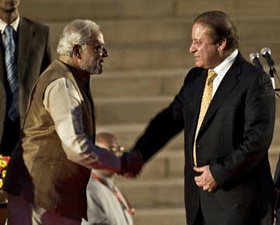Bull Run In Wake of Modi Mania Hikes Ambani, Adani Fortunes Dramatically
New Delhi: Prime Minister Narendra Modi swept to power on a tidal wave of bull sentiment in the market. It seemed though that the frenetic prelude to the long promised day of the Modi sarkar, had exhausted the bull operators. As the media spectacle of Modi and his team assuming office unfolded, the markets were settling down into a phase of relative sobriety.
Market observers were convinced that this was just a temporary blip. The ministerial team had met all expectations, but these were already programmed into the bull sentiment that gripped the market the day election results were in. The fervour of the investor in that phase may have resulted in some excesses and the market needed a few downward ticks to correct itself and restore the balance between buyers and sellers.

The day after the Modi team assumed office, Rakesh Jhunjhunwala, an investor who has attained the status of an oracle of the markets, was laying out what seemed a doctrine of buying in the stock market as a surrogate for patriotism: “I would advise all Indians to have faith in India and its markets. We should not be under-invested for the mother of all bull markets…. I believe we will all be pleasantly surprised by the longevity and magnitude of this bull market. Lest we forget, all that we need is God’s grace and elders’ blessings”.
There are some faint echoes here of a forecast made back in 1992, when the stock markets in the country were reacting with something approaching a frenzy to the first generation of “economic reforms”. “India is a turnaround scrip on the world market and I am bullish on it”, said the man who had earned the sobriquet of the “big bull”. When the 1992 Union Budget was presented, stock markets went into what seemed an unending spiral of joyous celebration, only to be caught up short in just a matter of days by a massive payments crisis. It then emerged that the bull run had been fuelled by funds illicitly channelled out of bank treasuries.
India’s markets have come a long way since then and the new salience of the foreign institutional investor (FII) as an entity that can determine its fortunes, makes this manner of sharp practice superfluous. Pampered by the kind of tax concessions that have no economic or ethical rationale, FIIs have been pouring money into the Indian markets since the reforms began, but especially so since 2003, when the India seemed to draw a lucky number in the global casino.
That was the year that the tide of speculative capital unleashed from the capital of the global economy, began washing up on the country’s shores. Within five years though, the sheen had begun to come off what was touted as India’s growth miracle. The global financial meltdown created conditions for a reverse flight of capital. And though some tinkering with the fiscal apparatus prevented economic catastrophe, the blustery self-confidence of a newly empowered middle-class had taken a hit.
Evidently because of the business-friendly persona he has always sought to project, Modi’s arrival on the national stage restored the interest of the foreign investor and acted in most other ways, as a tonic for the markets. Since he was named the BJP’s candidate for prime ministership in September 2013, foreign investors are believed to have pumped in Rs 1000 billion (one lakh crore) into the country. India’s richest man, Mukesh Ambani alone is estimated to have added Rs 310 billion (31,000 crore) to his fortune in the bull run since September. And Modi’s most intimate confidant in the business world, Gautam Adani, whose corporate imprint has been evident on every aircraft ride he has been on during his high-voltage campaign blitzkrieg, is believed to have more than tripled his personal net worth from Rs 110 billion (11,000 crore) in that period.
Around the middle of 2013, Adani shares were languishing in the market, burdened by the public knowledge that he had in his frenetic expansion in infrastructure, taken on an unsustainable volume of debt. His port operations were turning in a modest profit, but nowhere near sufficient to service company debt estimated at over Rs 11,000 crore. Power generation was running at a loss and seemed headed into a financial black hole, with accumulated company debt being Rs 38,000 crore.
Adani’s windfall gains in the market since September 2013 are probably his reward for backing the right horse in the race to political preeminence. And with the money that he has presumably made in rolling over his shares during the bull run, he may succeed in paring the mountain of debt that his enterprises have been carrying. How much good that would do him, without some special favours rendered from the policy domain, remains to be seen.
Bull-runs on the stock market tend to be self-fulfilling. The more people expect prices to go up, they more they put into the market and the more prices actually do go up — until that is, they ask for a payback and the market finds that it does not have sufficient real money, as against promissory notes and IOUs, to pony up.
The moment of reckoning for all the promises that have created the latest buying fervour on the markets, will come when the corporations that have made the greatest speculative gains reveal their performance parameters. Appeals to the patriotic duty to buy are then unlikely to withstand a hard assessment of corporate fundamentals.
Courtesy: thecitizen.in
Disclaimer: The views expressed here are the author's personal views, and do not necessarily represent the views of Newsclick
Get the latest reports & analysis with people's perspective on Protests, movements & deep analytical videos, discussions of the current affairs in your Telegram app. Subscribe to NewsClick's Telegram channel & get Real-Time updates on stories, as they get published on our website.
























